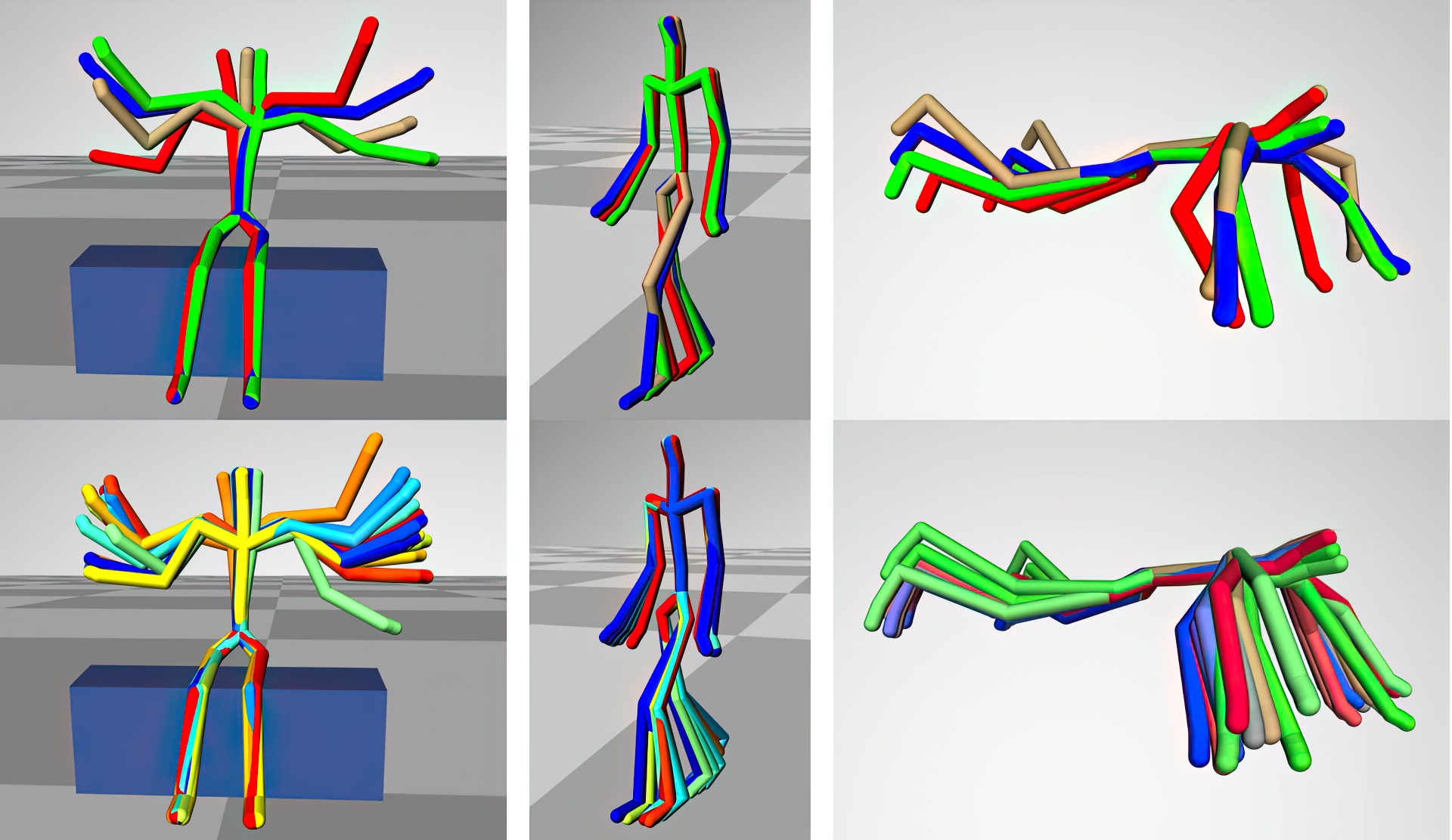“Modeling spatial and temporal variation in motion data”
Conference:
Type(s):
Title:
- Modeling spatial and temporal variation in motion data
Session/Category Title: Character animation
Presenter(s)/Author(s):
Moderator(s):
Abstract:
We present a novel method to model and synthesize variation in motion data. Given a few examples of a particular type of motion as input, we learn a generative model that is able to synthesize a family of spatial and temporal variants that are statistically similar to the input examples. The new variants retain the features of the original examples, but are not exact copies of them. We learn a Dynamic Bayesian Network model from the input examples that enables us to capture properties of conditional independence in the data, and model it using a multivariate probability distribution. We present results for a variety of human motion, and 2D handwritten characters. We perform a user study to show that our new variants are less repetitive than typical game and crowd simulation approaches of re-playing a small number of existing motion clips. Our technique can synthesize new variants efficiently and has a small memory requirement.
References:
1. Bodenheimer, B., Shleyfman, A. V., and Hodgins, J. K. 1999. The effects of noise on the perception of animated human running. In Computer Animation and Simulation 1999, N. Magnenat-Thalmann and D. Thalmann, Eds., 53–63.Google Scholar
2. Brand, M., and Hertzmann, A. 2000. Style machines. In SIGGRAPH 2000, 183–192. Google ScholarDigital Library
3. Chai, J., and Hodgins, J. K. 2007. Constraint-based motion optimization using a statistical dynamic model. In ACM Transactions on Graphics 2007, vol. 26 (3), 8. Google ScholarDigital Library
4. Chenney, S., and Forsyth, D. A. 2000. Sampling plausible solutions to multi-body constraint problems. In SIGGRAPH 2000, 219–228. Google ScholarDigital Library
5. Ernst, J., Vainas, O., Harbison, C. T., Simon, I., and Bar-Joseph, Z. 2007. Reconstructing dynamic regulatory maps. Molecular Systems Biology, 3:74.Google ScholarCross Ref
6. Friedman, N., Murphy, K., and Russell, S. 1998. Learning the structure of dynamic probabilistic networks. Uncertainty in Artifical Intelligence, 139–147.Google Scholar
7. Ghahramani, Z. 1998. Learning dynamic bayesian networks. C. L. Giles and M. Gori (eds.), Adaptive Processing of Sequences and Data Structures. Lecture Notes in Artificial Intelligence, 168–197. Google ScholarDigital Library
8. Harris, C. M., and Wolpert, D. M. 1998. Signal-dependent noise determines motor planning. Nature 394, 780–784.Google ScholarCross Ref
9. Hsu, E., Pulli, K., and Popović, J. 2005. Style translation for human motion. In ACM Transactions on Graphics 2005, vol. 24 (3), 1082–1089. Google ScholarDigital Library
10. Ikemoto, L., Arikan, O., and Forsyth, D. 2009. Generalizing motion edits with gaussian processes. In ACM Transactions on Graphics 2009, vol. 28 (1), 1. Google ScholarDigital Library
11. Jenkins, O. C., and Matarić, M. J. 2004. A spatio-temporal extension to isomap nonlinear dimension reduction. In ICML 2004, 441–448. Google ScholarDigital Library
12. Kovar, L., Gleicher, M., and Schreiner, J. 2002. Footskate cleanup for motion capture editing. In ACM SIGGRAPH/Eurographics Symposium on Computer Animation (SCA) 2002, 97–104. Google ScholarDigital Library
13. Kwon, T., Cho, Y.-S., Park, S. I., and Shin, S. Y. 2008. Two-character motion analysis and synthesis. IEEE Transactions on Visualization and Computer Graphics 14, 3, 707–720. Google ScholarDigital Library
14. Li, Y., Wang, T., and Shum, H.-Y. 2002. Motion texture: a two-level statistical model for character motion synthesis. In ACM Transactions on Graphics 2002, vol. 21 (3), 465–472. Google ScholarDigital Library
15. Maim, J., Yersin, B., and Thalmann, D. 2008. Unique instances for crowds. In Computer Graphics and Applications. Google ScholarCross Ref
16. McDonnell, R., Dobbyn, S., and O’Sullivan, C. 2006. Crowd creation pipeline for games. In International Conference on Computer Games, 181–190.Google Scholar
17. McDonnell, R., Larkin, M., Dobbyn, S., Collins, S., and O’Sullivan, C. 2008. Clone attack! perception of crowd variety. In ACM Transactions on Graphics 2008, vol. 27 (3), 26. Google ScholarDigital Library
18. Neapolitan, R. E. 2003. Learning Bayesian Networks. Prentice Hall. Google ScholarDigital Library
19. Perlin, K. 1995. Real time responsive animation with personality. IEEE Transactions on Visualization and Computer Graphics 1, 1, 5–15. Google ScholarDigital Library
20. Pullen, K., and Bregler, C. 2000. Animating by multi-level sampling. In Proceedings of Computer Animation, IEEE Computer Society, 36–42. Google ScholarDigital Library
21. Pullen, K., and Bregler, C. 2002. Motion capture assisted animation: Texturing and synthesis. In ACM Transactions on Graphics 2002, vol. 21 (3), 501–508. Google ScholarDigital Library
22. Rose, C., Cohen, M. F., and Bodenheimer, B. 1998. Verbs and adverbs: Multidimensional motion interpolation. IEEE Computer Graphics and Applications 18, 5, 32–41. Google ScholarDigital Library
23. Thalmann, D., Kermel, L., Opdyke, W., and Regelous, S. 2005. Crowd and group animation. ACM SIGGRAPH Course Notes. Google ScholarDigital Library
24. Wang, J. M., Fleet, D. J., and Hertzmann, A. 2008. Gaussian process dynamical models for human motion. In IEEE Transactions on Pattern Analysis and Machine Intelligence, vol. 30 (2), 283–298. Google ScholarDigital Library
25. Wiley, D. J., and Hahn, J. K. 1997. Interpolation synthesis of articulated figure motion. IEEE Computer Graphics and Applications 17, 6, 39–45. Google ScholarDigital Library
26. Yu, Q., and Terzopoulos, D. 2007. A decision network framework for the behavioral animation of virtual humans. In ACM SIGGRAPH/Eurographics Symposium on Computer Animation (SCA) 2007, 119–128. Google ScholarDigital Library





